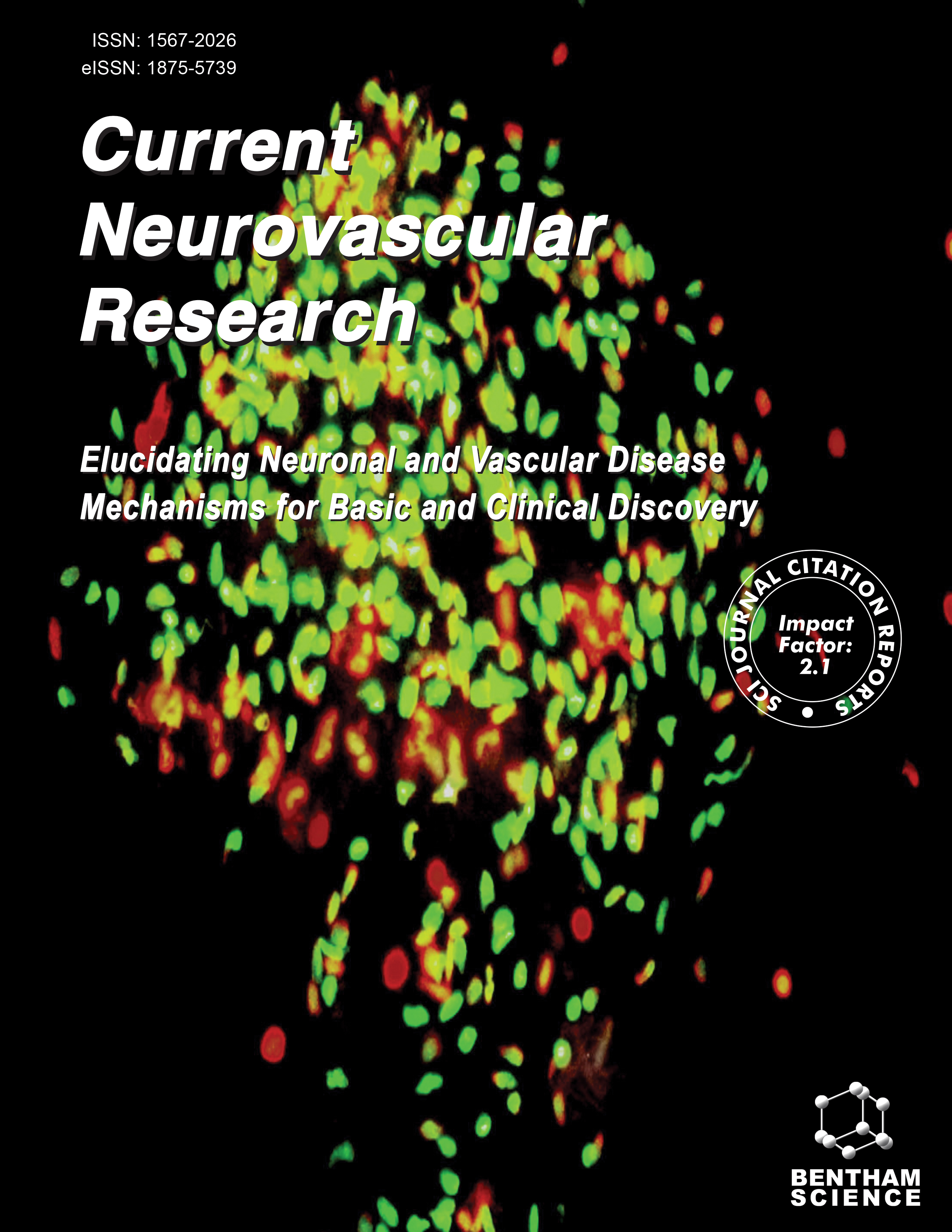- Home
- A-Z Publications
- Current Neurovascular Research
- Previous Issues
- Volume 2, Issue 1, 2005
Current Neurovascular Research - Volume 2, Issue 1, 2005
Volume 2, Issue 1, 2005
-
-
Amyloid Beta Peptide 1-40 Stimulates the Na+ / Ca2+ Exchange Activity of SNCX
More LessThe Na+ / Ca2+ exchangers, RNCX and SNCX, were cloned from mesangial cells of salt sensitive and salt resistant Dahl / Rapp rats, respectively, and differ at amino acid 218 (RNCXi / SNCXf) and in the exons expressed at the alternative splice site (RNCXB,D / SNCXB, D,F). These isoforms are also expressed in myocytes, neurons, and astrocytes where they maintain cytosolic calcium homeostasis. We demonstrated that cells ex Read More
-
-
-
Differential Susceptibility of Naive and Differentiated PC-12 Cells to Methylglyoxal-Induced Apoptosis: Influence of Cellular Redox
More LessAuthors: Masahiro Okouchi, Naotsuka Okayama and Tak Y. AwNeuropathologies have been associated with neuronal de-differentiation and oxidative susceptibility. To address whether cellular states determines their oxidative vulnerability, we have challenged naive (undifferentiated) and nerve growth factor-induced differentiated pheochromocytoma (PC12) with methylglyoxal (MG), a model of carbonyl stress. MG dose-dependently induced greater apoptosis (24h) in naive (nPC12) than differe Read More
-
-
-
Stroke Outcomes in Mice Lacking the Genes for Neuronal Heme Oxygenase-2 and Nitric Oxide Synthase
More LessAuthors: Khodadad Namiranian, Raymond C. Koehler, Adam Sapirstein and Sylvain DoreHeme oxygenase-2 (HO-2) has been suggested to be a cytoprotective enzyme in a variety of in vivo experimental models. HO-2, the constitutive isozyme, is enriched in neurons and, under normal conditions, accounts for nearly all of brain HO activity. HO-2 deletion (HO-2- / -) leads to increased neurotoxicity in cultured brain cells and increased damage following transient cerebral ischemia in mice. Moreover, pharmac Read More
-
-
-
Pathogenesis of Stroke-Like Episodes in MELAS: Analysis of Neurovascular Cellular Mechanisms
More LessAuthors: Takahiro Iizuka and Fumihiko SakaiThe pathogenesis of stroke-like episodes in mitochondrial encephalopathy, myopathy, lactic acidosis and stroke-like episodes (MELAS) is not fully understood although two main theories have been proposed; ischemic vascular hypothesis caused by “mitochondrial angiopathy” and generalized cytopathic hypothesis caused by “mitochondrial cytopathy”. Crucial molecular mechanism includes the lack of taurine modification at th Read More
-
-
-
Blood-Brain Barrier Alterations in MDX Mouse, An Animal Model of the Duchenne Muscular Dystrophy
More LessAuthors: Beatrice Nico, Luisa Roncali, Domenica Mangieri and Domenico RibattiThis article reviews recent studies on the alterations occurring in the brain vessel wall of the mdx mouse, an animal model with genetic defects in a region homologous with the human Duchenne muscular dystrophy (DMD) gene. These alterations affect both endothelial and astroglial cells and are associated with opened tight junctions, swollen perivascular astrocyte processes and a reduction in the expression of tight junctions Read More
-
-
-
Employing New Cellular Therapeutic Targets for Alzheimer's Disease: A Change for the Better?
More LessAuthors: Zhao Z. Chong, Faqi Li and Kenneth MaieseAlzheimer's disease is a progressive disorder that results in the loss of cognitive function and memory. Although traditionally defined by the presence of extracellular plaques of amyloid-β peptide aggregates and intracellular neurofibrillary tangles in the brain, more recent work has begun to focus on elucidating the complexities of Alzheimer's disease that involve the generation of reactive oxygen species and oxidati Read More
-
-
-
Cell Culture Models of Oxidative Stress and Injury in the Central Nervous System
More LessConstantly growing body of evidence suggests that hallmarks of oxidative stress are present in various central nervous system (CNS) disorders. Technological advantages in cell culturing made it possible to use neural cell / tissue cultures as experimental models for investigation of molecular mechanisms which underlie the development of oxidative stress condition, damage and adaptive responses to oxidative insults. This revi Read More
-
Volumes & issues
-
Volume 21 (2024)
-
Volume 20 (2023)
-
Volume 19 (2022)
-
Volume 18 (2021)
-
Volume 17 (2020)
-
Volume 16 (2019)
-
Volume 15 (2018)
-
Volume 14 (2017)
-
Volume 13 (2016)
-
Volume 12 (2015)
-
Volume 11 (2014)
-
Volume 10 (2013)
-
Volume 9 (2012)
-
Volume 8 (2011)
-
Volume 7 (2010)
-
Volume 6 (2009)
-
Volume 5 (2008)
-
Volume 4 (2007)
-
Volume 3 (2006)
-
Volume 2 (2005)
-
Volume 1 (2004)
Most Read This Month
Article
content/journals/cnr
Journal
10
5
false
en


